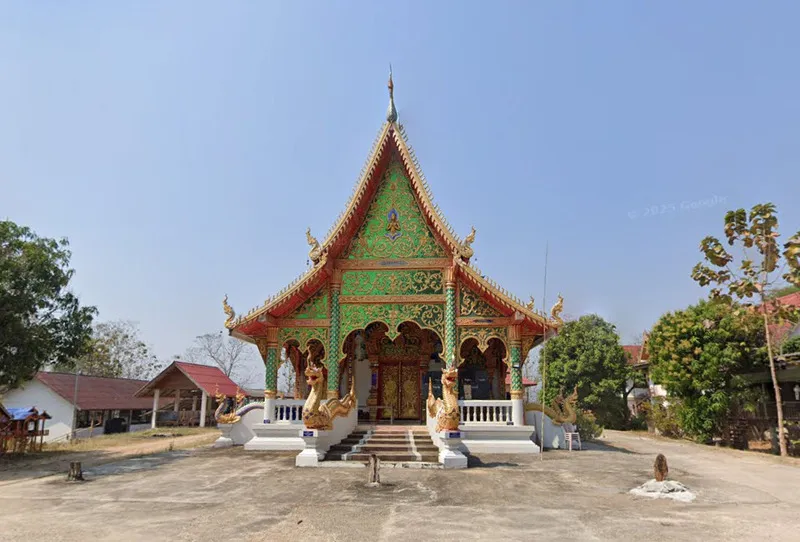Wat Thung Theng

Rating: 2.9/5 (7 votes)
Lampang attractions
Attractions in Thailand
Operating day: Daily
Operating time: 08.00 - 17.00
Wat Thung Tueng is located at number 148, Village No. 11, Si Bun Rueang, Mae Suk Subdistrict, Chae Hom District, Lampang Province, 52120. It is a private temple affiliated with the Mahanikaya sect and was officially established as a temple in 1905 (B.E. 2448).
The temple is situated on the eastern bank of the Soi River, adjacent to rice fields. The western boundary borders the Soi River, the southern side borders public land, and the northern side borders a public irrigation canal. There is no clear documentation indicating when the temple was originally built. Only oral traditions suggest that this place was once the site of an ancient temple, though its name and history remain unknown. The only remaining evidence is the ruins of an old vihara.
In 1905, Luang Pho Aphichai, who served as abbot, began restoring the temple and named it Wat Thung Tueng. The temple originally had two plots of land. The first plot, measuring 4 rai and 27 square wah, was where the temple was initially located. The second plot, about 100 meters away, measures 18 rai, 3 ngan, and 38 square wah, and is officially registered as temple property. In 1928 (B.E. 2471), a stupa was built on this second plot. Due to the elevated nature of the land, local villagers call the area “Mon Khao Soi.” This chedi was originally constructed on the first plot of land.
However, because the Soi River eroded the banks and caused annual flooding, which repeatedly damaged the temple, it was relocated in 1977 (B.E. 2520) to the second plot, which is on higher ground. This second plot, measuring 18 rai, 3 ngan, and 38 square wah, is now the main location of Wat Thung Tueng. The original plot has since become temple land once again, though no buildings remain on it. Nevertheless, monks and novices continue to stay there during the Buddhist Lent period.
Within the temple grounds, there are several important religious and historical artifacts, including three Chiang Saen-style bronze Buddha images in the Maravijaya posture (subduing Mara). The largest has a lap width of 45 cm and a height of 84 cm, the second has a lap width of 27 cm and height of 50 cm, and the third has a lap width of 16 cm and height of 34 cm. All three are estimated to be over 200 years old. There is also the Khao Soi Stupa, which is approximately 82 years old, and a stone inscription detailing the history of the stupa, measuring 51 cm in width and 64 cm in height, also around 82 years old. Additionally, the pulpit in the vihara measures 99 cm in width and 384 cm in height.
Comment
| Keyword (Advance) |
 Facebook Fanpage
Facebook Fanpage

 Category:
Category:  Group:
Group:  Art, Culture and Heritage
Art, Culture and Heritage Historical Sites and Monuments(
Historical Sites and Monuments( Landmarks and Memorials(
Landmarks and Memorials( Art, Craft Centres, Tradition(
Art, Craft Centres, Tradition( Museums(
Museums( Historical Houses and The Ancient City(
Historical Houses and The Ancient City( University
University Other religious and spiritural sites(
Other religious and spiritural sites( Research and Development
Research and Development Royal Project(
Royal Project( Suburban Living
Suburban Living Village, Community(
Village, Community( Local Market(
Local Market( Nature and Wildlife
Nature and Wildlife National Parks and Marine Reserves(
National Parks and Marine Reserves( Mountain (Doi)(
Mountain (Doi)( Dam, Reservoir, Lake(
Dam, Reservoir, Lake( Waterfalls(
Waterfalls( Hot Springs(
Hot Springs( Caves(
Caves( Flower Field(
Flower Field( River, Canal(
River, Canal( Bays and Beaches(
Bays and Beaches( Other natural attractions(
Other natural attractions( Entertainment and Agricultural
Entertainment and Agricultural Animal camps and shows(
Animal camps and shows( Farm, Parks, Gardens and Ecotourism(
Farm, Parks, Gardens and Ecotourism( Outdoor and Adventure Activities(
Outdoor and Adventure Activities( Shopping
Shopping Shopping and Night Market(
Shopping and Night Market( Spas and Wellness
Spas and Wellness Spas and Wellness(
Spas and Wellness(